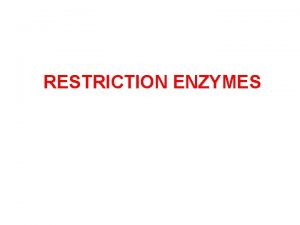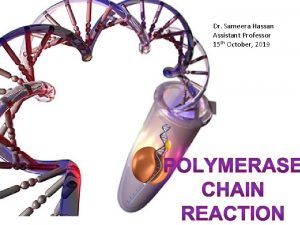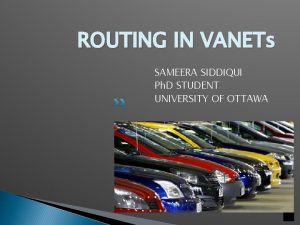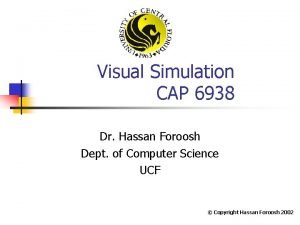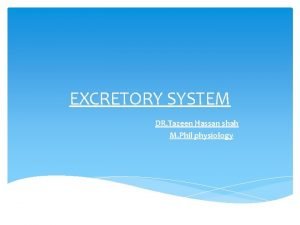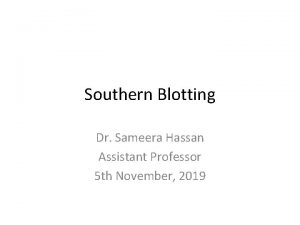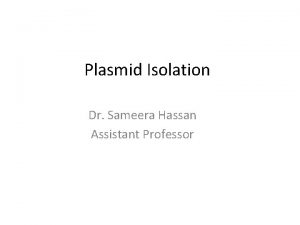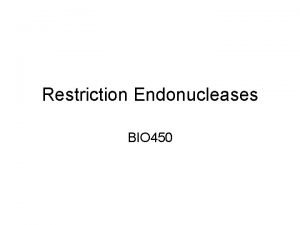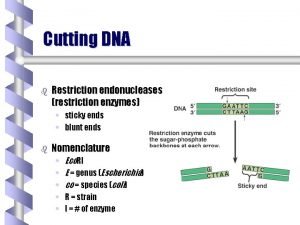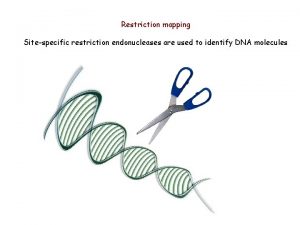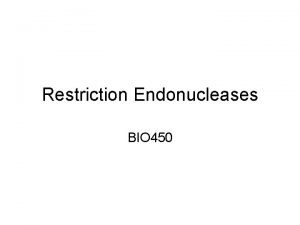RESTRICTION ENDONUCLEASES Dr Sameera Hassan Assistant Professor Restriction










- Slides: 10

RESTRICTION ENDONUCLEASES Dr. Sameera Hassan Assistant Professor

Restriction endonucleases • Restriction endonucleases are enzymes that cleave DNA in a sequence-dependent manner. Applications in molecular biology (a) establishment of an endonuclease map of a plasmid or bacteriophage clone; (b) fragmentation of genomic DNA prior to electrophoretic separation and Southern blotting; (c) generation of fragments that can be subcloned in appropriate vectors

DIGESTING A SINGLE DNA SAMPLE WITH A SINGLE RESTRICTION ENDONUCLEASE • Restriction endonuclease cleavage is accomplished simply by incubating the enzyme(s) with the DNA in appropriate reaction conditions. • The amounts of enzyme and DNA, the buffer and ionic concentrations, and the temperature and duration of the reaction will vary depending upon the specific application.

• 1 U restriction endonuclease completely digests 1 µg of purified DNA in 60 min using the recommended assay conditions. • However, crude DNA preparations, such as those made by rapid procedures , often require more enzyme and/or more time for complete digestion (see Critical Parameters). • The volume of restriction endonuclease added should be less than 1⁄10 the volume of the final reaction mixture, because glycerol in the enzyme storage buffer may interfere with the reaction. • Stop the reaction and prepare it for agarose or acrylamide gel electrophoresis by adding 5 µl (20% of reaction vol) 10× loading buffer.

• the reaction can also be stopped by chelating Mg 2+ with 0. 5 µl of 0. 5 M EDTA (12. 5 m. M final concentration). • If the digested DNA is to be used in subsequent enzymatic reactions (e. g. , ligation or “filling-in” reactions), addition of EDTA should be avoided. • Alternatively, many enzymes can be irreversibly inactivated by incubating 10 min at 65°C. Some enzymes that are partially or completely resistant to heat inactivation at 65°C may be inactivated by incubating 15 min at 75°C. • When the enzyme(s) is completely resistant to heat inactivation, DNA may be purified from the reaction mixture by extraction with phenol and precipitation in ethanol

Bam. HI cleavage generates cohesive 5′ overhanging ends: 5′ G↓G-A-T-C-C 3′ 3′ C-C-T-A-G↑G 5′ Kpn. I cleavage generates cohesive 3′ overhanging ends: 5′ G-G-T-A-C↓C 3′ 3′ C↑C-A-T-G-G 5′ Dra. I cleavage generates blunt ends: 5′ T-T-T↓A-A-A 3′ 3′ A-A-A↑T-T-T 5′

Isoschizomers • Endonucleases with the same recognition sequences are called isoschizomers. • Isoschizomers may or may not cleave DNA identically to produce the same ends. • Conversely, two or more restriction endonucleases recognizing identical or different sequences may generate identical DNA fragment termini; are said to produce compatible ends.

• For example, Bgl. II recognizes a different sixnucleotide sequence from Bam. HI, but generates cohesive termini compatible with those of Bam. HI. • Bgl. II cleaves: 5′ A↓G-A-T-C-T 3′ 3′ T-C-T-A-G↑A 5′ • The hybrid sites generated by joining Bam. HI and Bgl. II cohesive ends cannot be cleaved by either enzyme.

DIGESTING DNA WITH MULTIPLE RESTRICTION ENDONUCLEASES to choose a standard buffer solution in which two or more enzymes will retain activity if the reaction conditions needed are too dissimilar, then 1. If optimal digestion conditions differ only in incubation temperature, cleave the DNA with one enzyme, then shift the temperature and add the second enzyme (the order of cleavage does not matter) 2. For enzymes active at higher salt concentrations, add 1 M Na. Cl (1 to 3 µl for a 20 -µl reaction) so that the final concentration is suitable for digestion by the next enzyme(s). Add enzyme(s) for the second reaction and incubate appropriately.

DIGESTING MULTIPLE SAMPLES OF DNA • This procedure minimizes the number of pipetting steps when multiple samples are to be digested with the same enzyme(s) and, hence, saves time. • METHYLATION OF DNA
